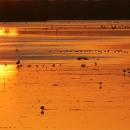About Us
J.N. "Ding" Darling National Wildlife Refuge, on the subtropical barrier island of Sanibel in the Gulf of America along Florida’s west coast, is part of the largest undeveloped mangrove ecosystem in the United States. It is world famous for spectacular migratory bird populations. The refuge was established in 1945 to safeguard and enhance the wildlife habitat of Sanibel Island, to protect endangered and threatened species, and to provide feeding, nesting, and roosting areas for migratory birds. In 1967, the refuge was renamed for conservation pioneer Jay Norwood “Ding” Darling, who was instrumental in its founding. More than 40 percent of the refuge is Congressionally designated wilderness.
Our Mission
The refuge's mission to safeguard and enhance the wildlife habitat of Sanibel Island, to protect endangered and threatened species, and to provide feeding, nesting, and roosting areas for migratory birds.
Our History
What began as a sandbar is now Sanibel, a barrier island fringed with mangrove trees, shallow bays, and white sandy beaches located off the southwest coast of Florida. For over 2,000 years the Calusa Indians made the lush island, with its ready source of food from the sea, their home. By the mid 1800s, European settlers arrived and soon displaced the Calusa tribe. For years the island was mainly used by farmers until a fierce hurricane in 1926 destroyed the agriculture industry. Construction of the Sanibel causeway in 1963 opened way for tourism on the island. Jay Norwood Darling was instrumental in the effort to block the sale of a parcel of environmentally valuable land to developers on Sanibel Island. At Darling's urging, President Harry S. Truman signed an Executive Order creating the Sanibel National Wildlife Refuge in 1945.The refuge was renamed in 1967 in honor of the pioneer conservationist.
Other Facilities in this Complex
The J.N. "Ding" Darling National Wildlife Refuge is managed as part of the Southwest Florida Gulf Coast National Wildlife Refuge Complex.
A National Wildlife Refuge Complex is an administrative grouping of two or more refuges, wildlife management areas or other refuge conservation areas that are primarily managed from a central office location. Some refuges are grouped into a refuge complex structure where they occur in a similar ecological region, such as a watershed or ecosystem, and have related purposes and management goals. Typically, a project leader oversees the general management of all refuges within the complex and refuge managers are responsible for operations at specific refuges. Supporting staff, composed of administrative, law enforcement, biological, fire, visitor services, and maintenance professionals, typically are centrally located and support all refuges within the complex.
The J.N. "Ding" Darling National Wildlife Refuge is part of a larger complex that encompasses the Caloosahatchee National Wildlife Refuge, Matlacha Pass National Wildlife Refuge, Pine Island National Wildlife Refuge, and Island Bay National Wildlife Refuge, Florida Panther National Wildlife Refuge, and Ten Thousand Islands National Wildlife Refuge. The majority of the lands in these refuges are nesting and roosting islands.








